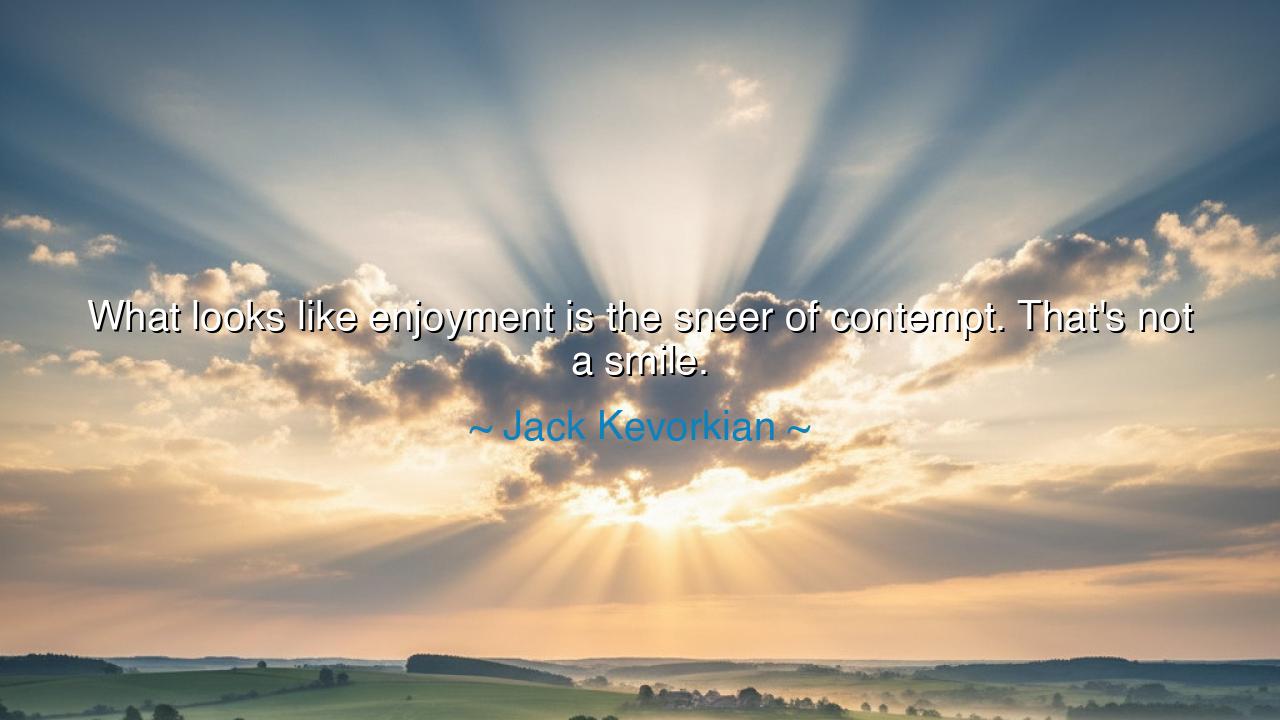
What looks like enjoyment is the sneer of contempt. That's not a






Jack Kevorkian, a man surrounded by controversy yet unflinching in his speech, once said: “What looks like enjoyment is the sneer of contempt. That’s not a smile.” In these words he pierces the veil of false appearances, warning us that not every lifted lip or bared tooth is born of joy. A true smile is the expression of the soul’s light, but a false one—shaped by scorn, bitterness, or cruelty—is nothing but a mask, a hollow imitation of joy. To confuse the two is to mistake poison for medicine.
The ancients knew well the danger of appearances. Plato wrote of the sophist, who cloaked deception in fine words, dazzling the crowd while hiding corruption within. Likewise, Kevorkian warns us that a sneer can wear the clothing of enjoyment, but its spirit is darker. The Greeks themselves drew a sharp line between the gelos of noble laughter, which heals and binds, and the mockery that wounds and humiliates. The latter was not laughter at all but contempt, the very thing Kevorkian calls out in his words.
History gives us vivid examples. Consider the court of France before the Revolution, where nobles laughed and “smiled” at the hunger of the peasants. Their expressions seemed to be of enjoyment, but beneath lay arrogance, cruelty, and disdain. That false mirth, mistaken by them as harmless jest, fanned flames of rage and brought down their kingdom. Here we see Kevorkian’s truth: what is not born of kindness is not a smile, but a mask of pride destined to collapse.
On the other hand, think of Abraham Lincoln, whose weary but genuine smile softened the bitterness of war. When he laughed, it was not mockery but humanity shining through the darkness. Soldiers, strangers, and even rivals found in that expression a reminder that they shared the same flesh, the same struggles. The contrast between a true smile and a false one is the contrast between healing and wounding, between a bridge and a wall.
Kevorkian’s insight is both warning and challenge. We live in a world full of masks, where cruelty often disguises itself as jest, and where contempt is paraded as cleverness. Yet we are called to discern: to look beyond the sneer, to recognize that not all that glitters is gold, not all that curves the lips is joy. And more than that, we are challenged to purify our own expressions, so that when we offer a smile, it may never wound, but always heal.
Mark this well: a true smile springs from compassion, from humility, from love. A false one springs from arrogance, from contempt, from pride. One unites, the other divides. One uplifts the weary, the other crushes the vulnerable. To mistake them is to blind oneself; to learn the difference is to walk in wisdom.
Practical wisdom follows: guard your expressions as you guard your words. Ask yourself, “Does this smile uplift, or does it wound? Does it bless, or does it belittle?” Strive to offer only those smiles that bring warmth, and refuse to cloak scorn in the garments of joy. For in the end, the world remembers not the clever sneer, but the genuine smile that healed a weary heart.
Therefore, O seeker, let Kevorkian’s hard truth be your guide: strip away falsehood. Do not mistake contempt for joy, nor allow your own mirth to harden into cruelty. Let your smile be the light of the soul, never the shadow of disdain. For only then will your joy be true, your laughter pure, and your presence a blessing to all who cross your path.






AAdministratorAdministrator
Welcome, honored guests. Please leave a comment, we will respond soon